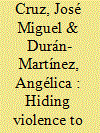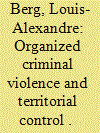|
|
|
Sort Order |
|
|
|
Items / Page
|
|
|
|
|
|
|
| Srl | Item |
| 1 |
ID:
141476


|
|
|
|
|
| Summary/Abstract |
There is increasing international concern about the growth of organized crime in Africa. Important criminal organizations and professional criminals are present in Africa, but we argue that the term “organized crime” is not a very useful description of their activity, since what we are actually witnessing is a reformulation of politics and crime into networks that transcend the state/non-state boundary in ways that are hardly subsumed in standard concepts of organized crime. Similar processes are taking place in various parts of the world, and thus African countries are not exceptional in this regard. The process, however, does take particular forms in Africa that arise out of the histories of individual countries. The article describes the evolution in countries as diverse as Libya, Guinea-Bissau, and Zimbabwe of a market for protection, as business people – legitimate and otherwise – seek protection for their activities and their personnel. This market for protection is created by making private arrangements, often with state officials working in private capacities. The implications are profound: they could amount to a new mode of governance connecting Africa to international markets and institutions in which the distinctions between licit and illicit economic activity become difficult to detect.
|
|
|
|
|
|
|
|
|
|
|
|
|
|
|
|
| 2 |
ID:
144085


|
|
|
|
|
| Summary/Abstract |
In 2012, the two major street gangs in El Salvador, Mara Salvatrucha 13 and Barrio 18, struck a truce credited with reducing homicide rates by more than 50% in one year. Although the gang truce held for only 18 months, the significant reduction in homicides puzzled observers that believed youth gangs were unable to coordinate violence, especially considering that previous and similar efforts aimed at striking agreements did not achieve similar results. This article addresses a question posed by the puzzle of the Salvadoran truce’s success: under what conditions do negotiations between or with criminal organizations effectively reduce criminal violence? By comparing truces and criminal pacts in El Salvador and in Medellin, Colombia, we argue that criminal pacts can reduce homicides when (a) they directly involve the state as an administrator of incentives to reduce violence and (b) criminal organizations have achieved organizational cohesion and leadership that facilitate territorial control and strategic dependability. These conditions allow organizations to regulate violence. Our argument highlights the importance of how violence is performed and, more importantly, its visibility, to fully understand criminal behavior within pacts. It also points to potential lessons for countries seeking alternatives to reduce criminal and political violence in Latin America and elsewhere.
|
|
|
|
|
|
|
|
|
|
|
|
|
|
|
|
| 3 |
ID:
170585


|
|
|
|
|
| Summary/Abstract |
Across the region, criminal organizations collude with the state, maintain local political order, and help nominate and elect politicians.” Fifth in a series on ways of governing.
|
|
|
|
|
|
|
|
|
|
|
|
|
|
|
|
| 4 |
ID:
112344


|
|
|
|
|
| Publication |
2012.
|
| Summary/Abstract |
Around the world, criminal organizations and governments are fusing to an unprecedented degree, blurring the distinction between national interests and what suits the gangsters. Mafia states enjoy the unhealthy advantages of their hybrid status: they're as nimble as gangs and as well protected as governments, and thus more dangerous than either.
|
|
|
|
|
|
|
|
|
|
|
|
|
|
|
|
| 5 |
ID:
161548


|
|
|
|
|
| Summary/Abstract |
What accounts for geographic variation in organized criminal violence? In Honduras, a country with one of the highest homicide rates in the world, the intensity of violence rivals many civil wars. Yet violent crime varies across cities and neighborhoods. Armed groups seeking to control territory use violence for different purposes, including competing against rivals, coercing residents and state officials, and exploiting the public for profit. Variations in community organization, defined as the density of interpersonal ties and the prevalence of shared expectations for collective action, affect the utility of violence for each of these purposes. Community organization can raise the cost of controlling territory, reduce the benefits of coercive violence, and generate pressure to protect residents from exploitation. These dynamics are examined through a comparison of nine neighborhoods in three of Honduras’s most violent cities, drawing from disaggregated homicide data and ethnographic research. The comparison shows that neighborhoods with denser community organization experienced lower levels of violence. Narrative evidence points to specific ways in which community organization mediates effects of competition among criminal groups and their interaction with state officials. Community characteristics thus affect the way non-state armed actors exercise authority in areas of limited state presence.
|
|
|
|
|
|
|
|
|
|
|
|
|
|
|
|
| 6 |
ID:
087460


|
|
|
|
|
| Publication |
2009.
|
| Summary/Abstract |
It is difficult to measure the size, influence and growth patterns of criminal organizations embedded in illegal markets. In this paper, we argue that measuring the influence of a criminal organization by its size (in number of employees, or 'members') may under- or overestimate its sphere of influence in illegal markets. Self-report survey and size of population methodologies are combined to assess the regional economic influence of a criminal organization (Hells Angels) in three illegal drug markets (the cocaine trade, the cannabis trade and the cannabis cultivation industry) in the province of Qu bec. Findings suggest that a relatively small organization by conventional standards can nonetheless achieve a large influence on criminal markets. We then analyse how factors other than violence play a role in explaining differences in achieving economic influence across criminal organizations. Finally, we suggest that turning our attention to measuring economic influence provides some insights into the duration and intensity of the violent conflicts occurring in these markets.
|
|
|
|
|
|
|
|
|
|
|
|
|
|
|
|
| 7 |
ID:
008456


|
|
|
|
|
| Publication |
Winter 1995.
|
| Description |
57-72
|
|
|
|
|
|
|
|
|
|
|
|
|
|
|
|
|
|
|
|
|